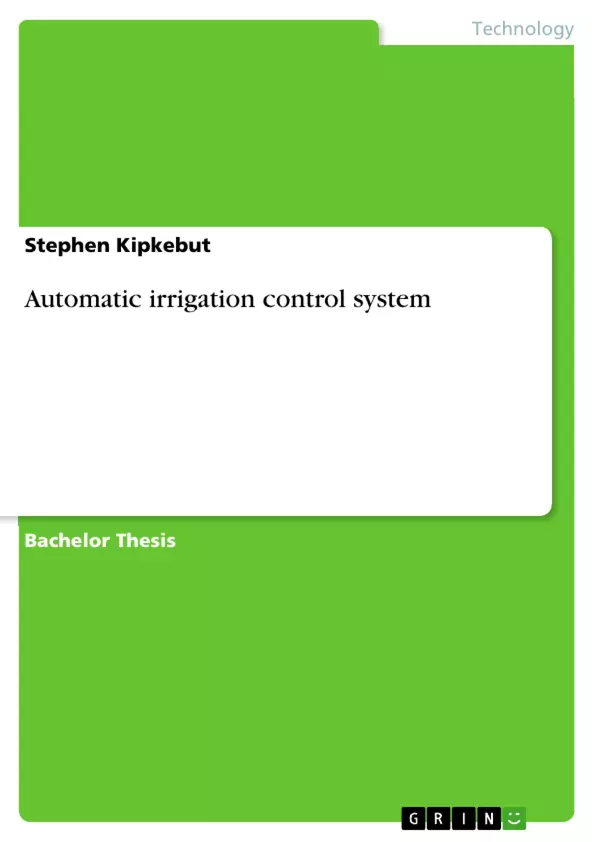This project is based on moisture sensor used to measure humidity content in the soil. The design portion involves mainly a global system for mobile communication and a control circuitry with a microcontroller. This project used some of the softwares like basic language for programming the application software to the microcontroller and visual basic for interfacing the hardware and mobile phone. Protel or workbench schematic software is used for designing the circuit diagram for this project and express prefabricated circuit board (PCB) software is used for designing. Since PCB making is a big process and involves a number of machineries which are expensive and was therefore outsourced. Using DTMF 8870 IC will act as an interface between the user and the system as it is a receiver which links the GSM network, the microcontroller pic16f73 contains the software which states the conditions of the system which can be displayed in a liquid crystal display and transmitted via mobile phone to the dual tone multiple frequency receiver which is part of the control system in the farm. New technologies help in increasing productivity with use of less manpower as well as conservation of water in the process.
Table of Contents
- Chapter 1: Introduction
- 1.0.0 Introduction
- 1.0.1 Justification
Objectives and Key Themes
The main objective of this project is to develop an automatic irrigation control system that optimizes water usage and enhances food production efficiency in Kenya. This system will utilize a moisture sensor, microcontroller, and mobile phone communication to monitor soil conditions and remotely control irrigation, minimizing water waste and human intervention.
- Water conservation in irrigation
- Automation of irrigation systems
- Utilization of technology for efficient food production
- Remote monitoring and control of irrigation systems
- Addressing Kenya's food security challenges
Chapter Summaries
Chapter 1: Introduction: This chapter introduces the problem of water scarcity in Kenya and its impact on agriculture. It highlights the need for efficient irrigation systems to address food security concerns and the increasing population. The chapter discusses different types of irrigation systems, their limitations, and the advantages of automation. It emphasizes the project's goal of creating an automated system using a moisture sensor, microcontroller, and mobile phone communication for remote monitoring and control, improving water management and reducing reliance on manual operation. The chapter lays the groundwork for the project by detailing the context of water scarcity in Kenya, highlighting the necessity of advanced irrigation techniques, and emphasizing the role of technology in optimizing water usage and improving food production. References to statistics on Kenya's water resources and population growth underscore the urgency and importance of the project. The introduction of the proposed system and its key features sets the stage for the following chapters detailing its implementation and functionality.
Keywords
Network, Microcontroller, Conservation, Global system for mobile communication, Irrigation, Automation, Water scarcity, Food security, Kenya, Moisture sensor, Remote monitoring, DTMF
Frequently Asked Questions: Comprehensive Language Preview of Automated Irrigation Control System
What is the main objective of this project?
The primary goal is to create an automated irrigation system for Kenya that optimizes water usage and boosts food production efficiency. This involves using a moisture sensor, microcontroller, and mobile phone communication for remote monitoring and control.
What are the key themes explored in this document?
The document focuses on water conservation in irrigation, automation of irrigation systems, leveraging technology for efficient food production, remote monitoring and control, and addressing Kenya's food security challenges.
What is covered in Chapter 1: Introduction?
Chapter 1 introduces the problem of water scarcity in Kenya and its impact on agriculture. It explains the need for efficient irrigation, discusses different irrigation systems and their limitations, and details the project's proposed automated system using a moisture sensor, microcontroller, and mobile phone communication for remote monitoring and control. It sets the stage for subsequent chapters.
What are the key technologies used in the proposed system?
The system utilizes a moisture sensor, a microcontroller, and mobile phone communication (likely referencing Global System for Mobile Communications or GSM technology) for remote monitoring and control.
What are the key benefits of the proposed automated irrigation system?
The system aims to conserve water, automate irrigation processes, improve food production efficiency, enable remote monitoring and control, and ultimately contribute to addressing food security issues in Kenya.
What keywords are associated with this project?
Key terms include: Network, Microcontroller, Conservation, Global System for Mobile Communication (GSM), Irrigation, Automation, Water scarcity, Food security, Kenya, Moisture sensor, Remote monitoring, DTMF.
What is the structure of the document preview?
The preview provides a table of contents, objectives and key themes, chapter summaries (specifically for Chapter 1), and a list of keywords.
Where can I find more detailed information about this project?
This document is a preview; more comprehensive details would be found in the full project report or documentation.
- Citation du texte
- Stephen Kipkebut (Auteur), 2014, Automatic irrigation control system, Munich, GRIN Verlag, https://www.grin.com/document/286712



